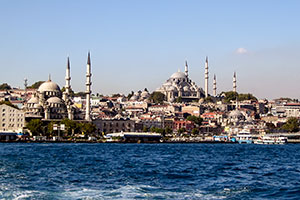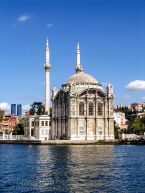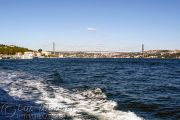The Bosphorus separates the European and the Asian parts of Istanbul. In its most narrow part the Bosphorus or Boğaz in Turkish, is only 650 meters wide and its maximum separation is 4.5 km. The Bosphorus strait is 35 km long and connects the Marmara Sea in the south to the Black Sea in the north. It is spanned by three large bridges: the Bosphorus Bridge or Boğaziçi Köprüsü, which was opened in 1973 at the 50th anniversary of the Turkish Republic; the Fatih Sultan Mehmet Köprüsü (bridge of Sultan Mehmet the Conqueror), which became in use in 1988 and has a ten meter larger span, and finally the Yavuz Sultan Selim Köprüsü, which was opened to traffic in August 2016.
Leaving Istanbul's urban congestion, an all day boat trip along the Bosporus, passing small towns and summer mansions, is always appreciated. This mini-cruise is cheaply organized by public ferry leaving from the Eminönü-Kavaklar Boğaziçi Özel Gezi Seferleri (Eminonu-Kavaklar Bosphorus Special Touristic Excursions) at 10.35 (be sure to be on board at least half an hour before departure). An alternative is provided by Dentur Avrasya Bosphorus Tour that leaves at Kabataş Iskele. The boat stops at Beşiktaş (Europe), Kanlıca (Asia), Yeniköy (Europe), Sarıyer (Europe), Rumeli Kavağı (Europe), and finally after 1.5 hour arrives at Anadolu Kavağı (Asia) at the mouth of the Black Sea.
The journey passes first Karaköy, the district just across the Galata Bridge, then passes the Dolmabahçe Mosque and Palace, which were built between 1843 and 1856 on the order of Sultan Abdülmecid by the Armenian architect Garabet Balian and his son Nikoğos. The Dolmabahçe mosque was finished in 1853 and is built in Ottoman baroque-rococo style. The mosque is known for having the finest minarets of Istanbul. Next, the boat passes the Çırağan Palace with its 300 m marble facade facing the shore. The Çırağan palace was built in 1874 under the directive of Sultan Abdülaziz, destroyed by fire on January 19, 1910 and has been restored as a grand hotel (Çırağan-Kempinsky Hotel). At Ortaköy, the next stop, artists gather every Sunday to exhibit their works in a street side gallery. In Ortaköy, a church, a mosque, and a synagogue have existed side by side for centuries, a tribute to Turkish tolerance. The Ortaköy Mosque is superbly situated on a point extending into the Bosphorus. The mosque was built under the directive of Sultan Abdülmecid in 1854-55 by the Armenian architect Nikoğos Balyan, who designed it in Ottoman baroque-rococo style. The wide, high windows let the ever-changing light reflections of the Bosphorus shine in the mosque. The mosque is now overshadowed by one of the world’s largest suspension bridges, the Bosphorus Bridge, linking Europe and Asia. The Bosphorus bridge or Boğaziçi Köprüsü is a suspension bridge of about 1560 metres long, going between Ortaköy in Europe and Beylerbeyi in Asia. It was the first bridge built over the Bosphorus and the construction was finished in 1973. After the attempt of a military coup in July 2016, the bridge has been renamed as 15 July Martyrs Bridge (15 Temmuz Şehitler Köprüsü)
https://turkeyphotoguide.com/bosphorus-tour?tmpl=component&print=1&layout=default#sigProId07a475732f
From Ortaköy onwards, the boat passes the historic fortresses of Rumeli Hisarı and Anadolu Hisarı. The fortress of Rumeli Hisarı was constructed in just 4 months and 16 days by Sultan Mehmed II in 1452 in preparation for the siege of Constantinople the following year. The fortress is now overshadowed by the Fatih Sultan Mehmet Bridge (Bridge of Sultan Mehmed the Conqueror), completed in 1988 this is one of the world's longest suspension bridges (1090 m). The bridge spans the Bosphorus at the point where King Darius of Persia crossed the straits by a pontoon bridge in 512 BC. Opposite Rumeli Hisarı, on the Asian side of the Bosporus, is Anadolu Hısarı a fortress built in the late 1300s by Sultan Beyazid I. When both fortresses were completed, they effectively closed the straits for any help coming to Constantinople from the north.
After Rumeli Hisarı the shores become occupied with small fishing villages and summer residences for the wealthy. Most of these residences are beautifully carved wooden mansions called yalı and are priceless jewels that adorn the shores of the Bosphorus. Once, there used to be countless of these waterside residences, but fire, destruction and time itself took its toll. One of the most impressive of these mansions is certainly the Sait Halim Paşa Yalı at Yeniköy. This yalı was badly damaged by fire in 1995. The mansion was designed by architect Petraki Adamanti in the 19th century and took its name from Egyptian Khedive Mehmet Ali Paşa's grandson, Sait Halim Pasha.
At the village of Yeniköy magnificent yalıs line the shore. Yeniköy has developed in recent years and now offers a number of cute cafes and an array of restaurants (Italian, Chinese, Fish). Many foreigners also choose Yeniköy for their residence and the hills are loaded with villas and gated compounds. The building of the Austrian Consulate is one of the impressive structures in Yeniköy
Finally, after 1.5 hour we reach the Black Sea and the boat stops at Anadolu Kavağı, a small fishing village on the Asian shore. Here, there is plenty of time for a walk and a lunch with delicious hamsi (anchovis) and rakı. The boat returns to Eminönü İskele at 3 pm.
https://turkeyphotoguide.com/bosphorus-tour?tmpl=component&print=1&layout=default#sigProId902691d42d




































